PRESENTATION: Umar Rashid
 Many of Umar Rashid’s works have a political commentary anchored in the darker side of history, but Rashid lightheartedly proposes alternative narratives that play upon power dynamics. Residing somewhere between humor and protest, his works evoke awareness of the majority of individuals whose stories and lives have been erased from history.
Many of Umar Rashid’s works have a political commentary anchored in the darker side of history, but Rashid lightheartedly proposes alternative narratives that play upon power dynamics. Residing somewhere between humor and protest, his works evoke awareness of the majority of individuals whose stories and lives have been erased from history.
By Dimitris Lempesis
Photo: Blum Gallery Archive
Umar Rashid makes paintings, drawings, and sculptures that chronicle the grand historical fiction of the Frenglish Empire (1648–1880) that he has been developing for over seventeen years. Each work represents a frozen moment from this parallel world that often recalls our own fraught histories—both canonized and marginalized—with familiar signifiers and iconographies that channel the visual lexicons of hip hop, ancient and modern pop culture, gang and prison life, and revolutionary movements throughout time. This alternative history and its many subplots are told with elaborate visual and literary detail—with painterly tableaus depicting large networks of protagonists that relate to one another across bodies of work, and with lyrical and humorous artwork titles often a paragraph in length. Each exhibition is produced in response to the geographical locale of the host site; each time, Rashid builds upon his encyclopedic knowledge of global colonial history and conjures new fabulations that underline the roles of race, gender, class, and power in the tales of what was, what was recorded, what was negated, and what could have been.Umar Rashid’s solo exhibition “The Kingdom of the Two Californias. La Época del Totalitarismo Part 2”, is the second installment in Rashid’s “Epoch of Totalitarianism” series rejoins the artist’s fictional Frenglish conquerors—whose visual tale the artist has authored for upwards of fifteen years—in the 1800s as they attempt to maintain a stronghold in the Americas. Drawing an intentional parallel to the history of the Spanish Empire in the Californias, Rashid emphasizes the power of the colonial Frenglish as he portrays them with hyperbolic advantages such as weaponry from the twenty-first century, vibrant red muscle cars, and superhuman powers. At the core of this embellished retelling is Rashid’s signature mode of allegorical critique and revisioning of the histories embedded within the location of his exhibitions. “The Kingdom of the Two Californias” links the colonial legacy of the former region of Las Californias with California’s contemporary issues of racial inequity and police violence as witnessed in the 1992 Los Angeles Rebellion, the 2006 march against House Resolution 4437, and much more. Acting as a table of contents or a teaser for the exhibition’s narrative, “The West Coast is the Best Coast. Or, Map of the Two Californias. 1799-1800” (2024), offers viewers a map of the California coastline from San Francisco to Baja. Dotted amongst recognizable city names are the epic battles that Rashid illustrates as part of this presentation. Figures of fallen soldiers, aquatic monsters, women in early 1800s finery, and much more, further freckle this landscape—all foreshadowing the parabolic tableaus that wait in the next rooms. Peering through “Ishtarian Stargate to points unknown and, right here”. (2024) as if traveling back through time, our story begins on the first room’s north wall. “The Battle of Los Cabos (Ante up!) Or, The Daquan Maneuver” (2024) tells of the explosive Battle of Los Cabos—the Frenglish rendition of the Battle of San José del Cabo in the Mexican-American War. Setting the tone for the rest of the exhibition, each canon’s flight path scribes a quip of introspection such as “STAGE OF REMORSE REGRET” or “WHAT SHOULD WE HAVE DONE?” In the next room, :Cosmic lovers leap through the monolith into Pomo country. The Russian trappers engage a beast, Human lovers caress against the stone. A starship attempts an abduction. Or. Owl bear don’t give a shit and why don’t aliens abduct people of color?” (2024) depicts a lush scene in Northern California where native residents fight a colonial fur trapper with crossbows—only to have their target whisked away by a spaceship. This otherworldly technology lightly references the influx of tech money in the Bay Area that has displaced so many—particularly the Latinx population of San Francisco’s Mission District, which declined from 51.9 percent in 1990 to 34.7 percent in 2020. That fact that the Mission District’s name originates from Mission San Francisco de Asís, established there by the Spanish in 1776 to oversee and convert the Native Americans, further reinforces Rashid’s critique of generational oppression. In the final room of the exhibition,” No more parties in L.A. Or. The cause has a cost. Run that!” (2024) features a banner declaring “NO MORE PARTIES IN LA” seemingly in direct retort to the banner of “All Tomorrow’s Parties” in the exhibition’s first room—indicating that those who have been taken advantage of will endure it no longer. In “No more parties in L.A. Or. The cause has a cost. Run that!” Rashid’s rebels have organized to defeat their colonial oppressors—providing an optimistic anecdote to this chapter in the Frenglish chronicles. Across the room, Rashid’s large portrait of “Jairo and Anastasia. The dynamic duo of love, money, and fighting.” (2024) look on in triumph.
Photo: Umar Rashid, All tomorrow’s parties (San Bernardino edition) Or, an 18th century Benetton ad, painted at a liberal naturalist’s pool, where food, drinking, music, and torture are interrupted by a Franciscan acolyte seeking revenge for his father’s house smoldering in the background., 2024, Acrylic and ink on canvas, Three parts; 72 x 252 3/8 x 1 1/2 inches overall, Photo: Hannah Mjølsnes, © Umar Rashid, Courtesy the artist and Blum Gallery
Info: Blum Gallery, 2727 South La Cienega Boulevard, Los Angeles, CA, USA, Duration: 2/11-21/12/2024, Days & Hours: Tue-Sat 10:00-18:00, https://blum-gallery.com/
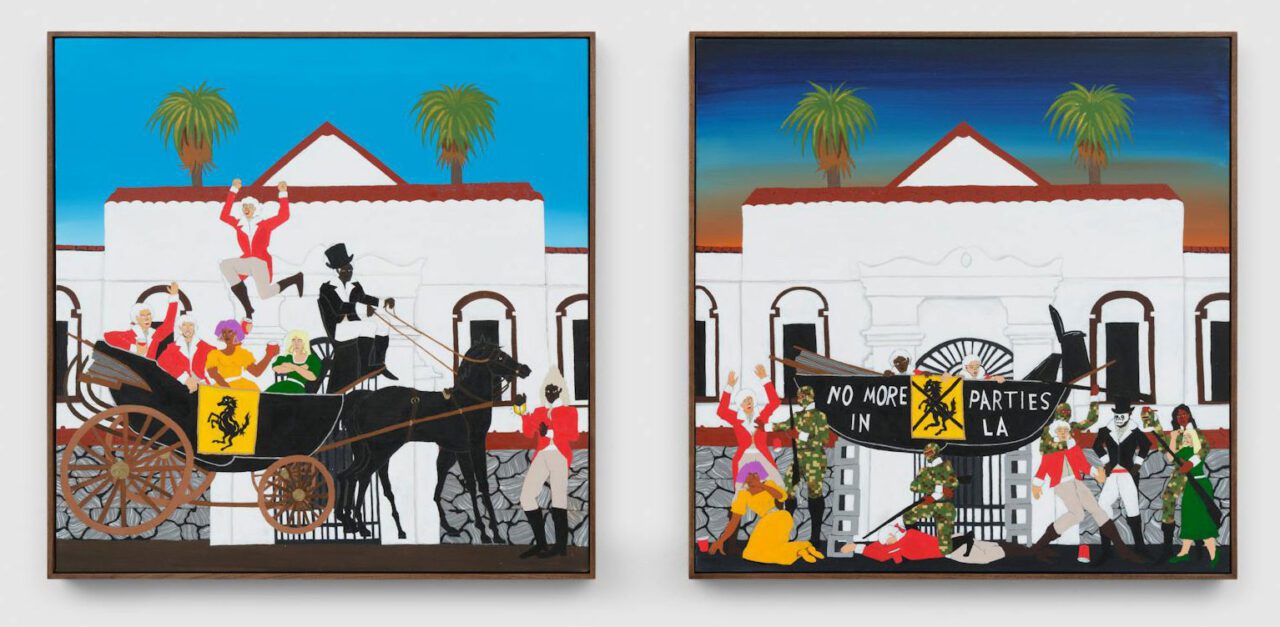
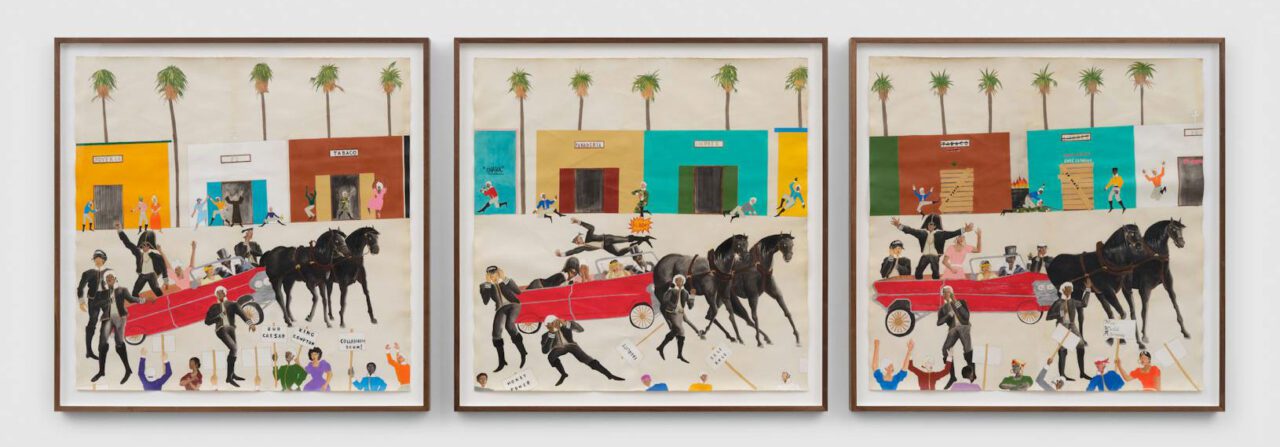



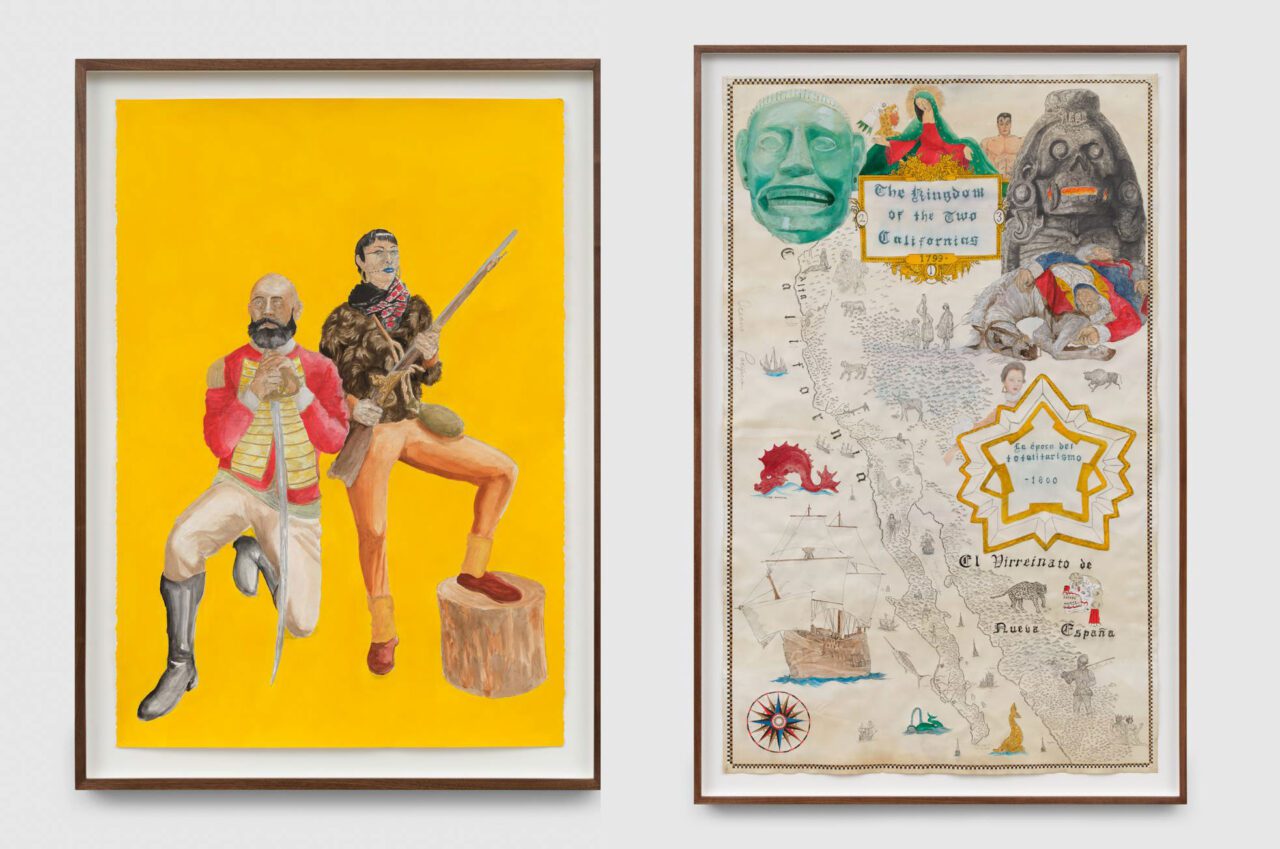
Right: Umar Rashid, The West Coast is the Best Coast. Or, Map of the Two Californias. 1799-1800, 2024, Acrylic, ink, coffee, and tea on paper, 77 1/8 x 50 1/4 x 2 inches framed, Photo: Hannah Mjølsnes, © Umar Rashid, Courtesy the artist and Blum Gallery
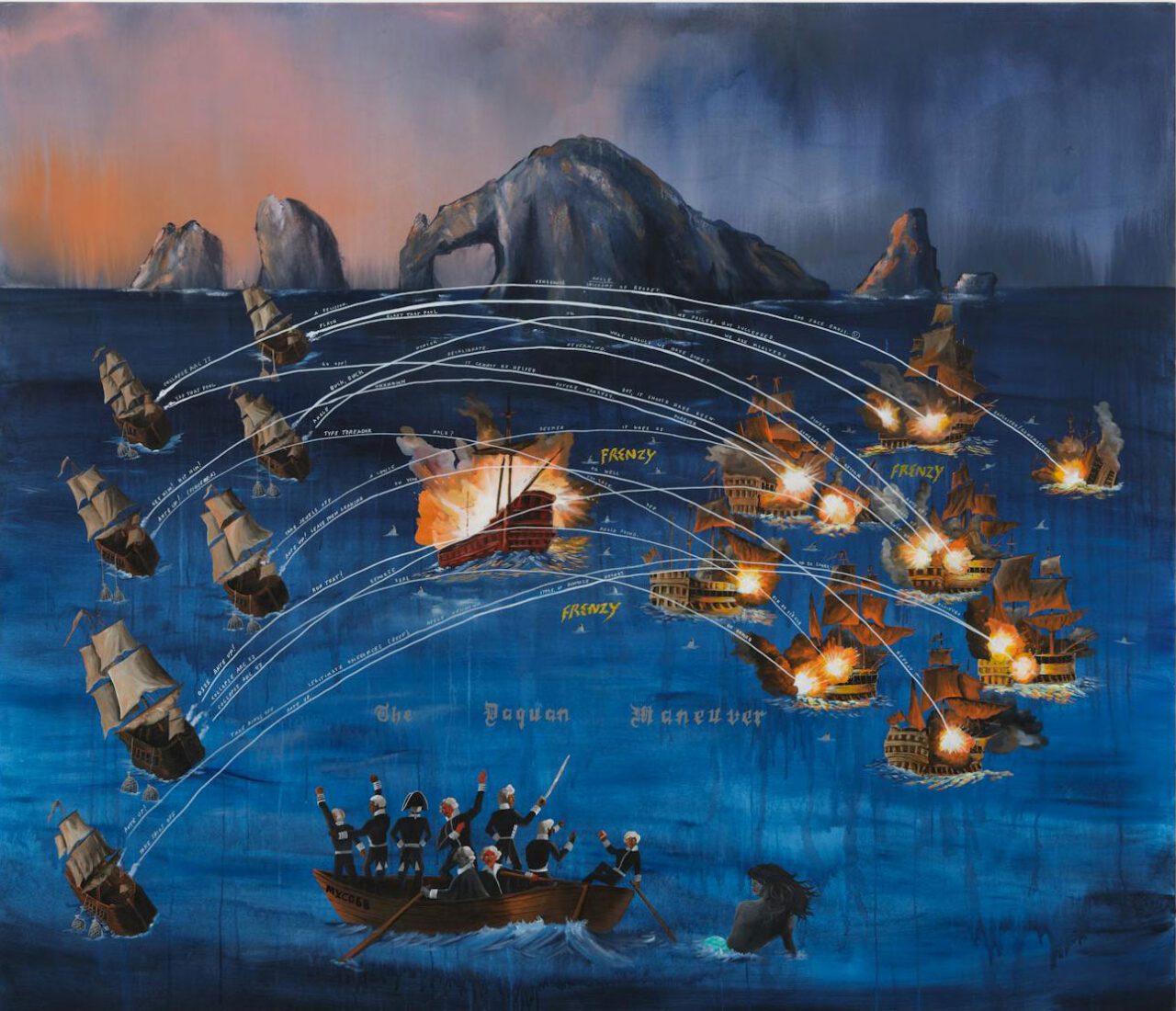
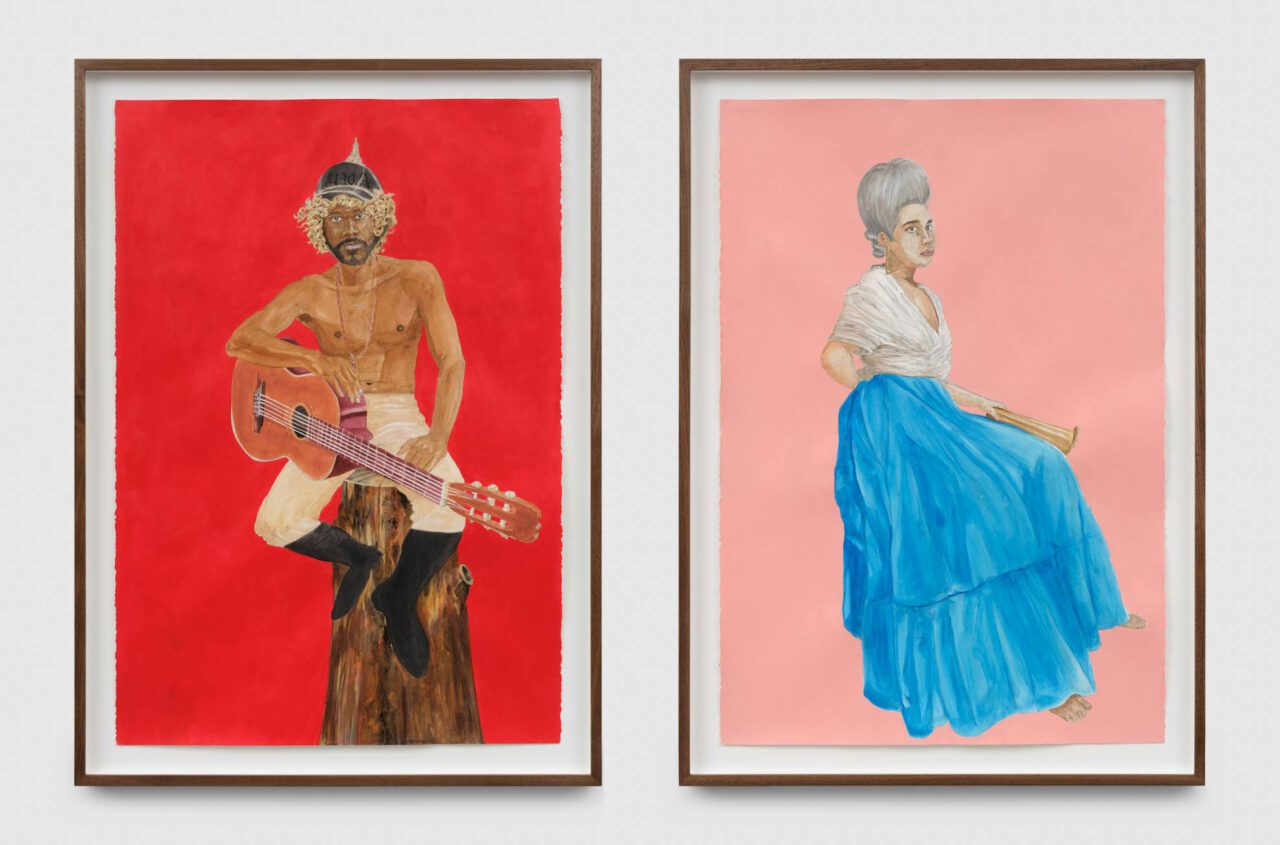
Right: Umar Rashid, Carlota, the gray (mulattress), 2024, Acrylic and ink on paper, 49 1/8 x 35 5/8 x 2 inches framed, Photo: Hannah Mjølsnes, © Umar Rashid, Courtesy the artist and Blum Gallery
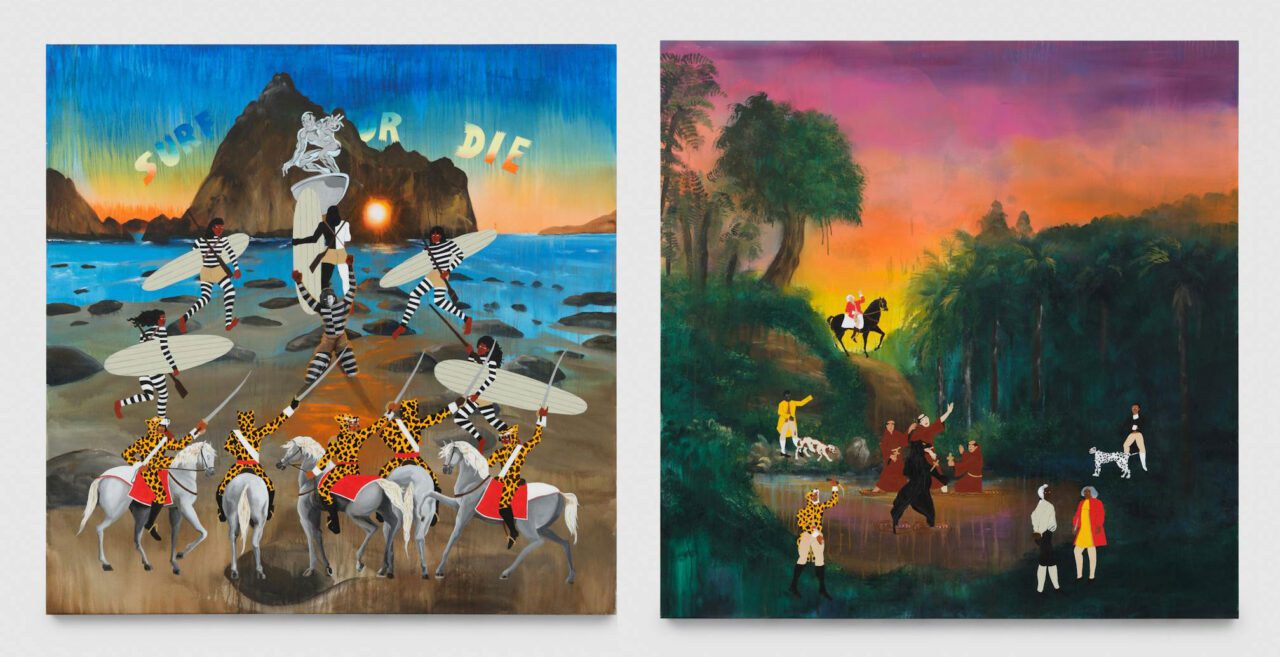
Right: Umar Rashid, The poetry of pre-dusk and defiance and that slow, “so long” sojourn from the crest of that hill in the wilds of Veracruz, behind the sea. Abandoning all to the weight of their contemplations. Or. Good luck, baptizing that jaguar, motherfuckers!, 2024, Acrylic and ink on canvas, 72 x 72 x 1 1/2 inches, Photo: Hannah Mjølsnes, © Umar Rashid, Courtesy the artist and Blum Gallery


